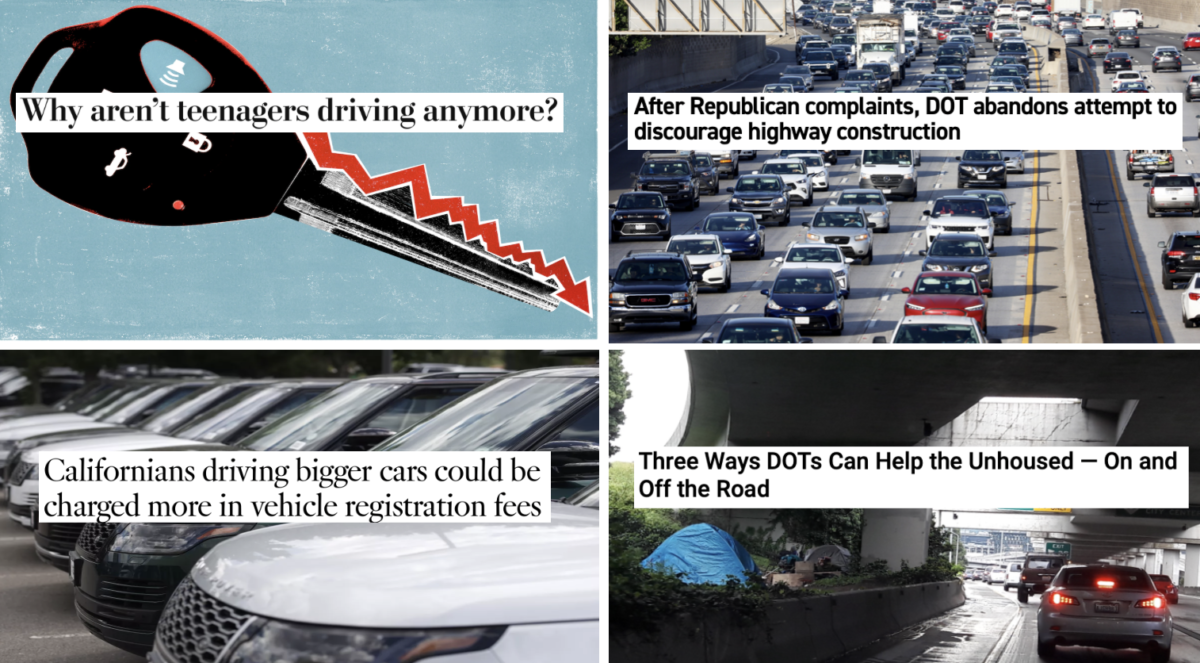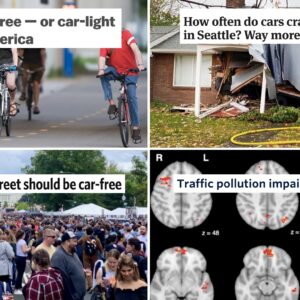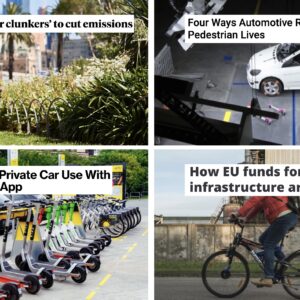Welcome to the week. Hope you’re staying warm and safe from the cold temps and ice!
Here are the most notable stories our writers and readers have come across in the past seven days…
Another look at why young people aren’t driving as much: In last week’s Monday Roundup, we featured a story from The Economist about why young people in North America and Europe are turning away from cars as transportation. But the media momentum for this phenomenon isn’t over yet. Here’s another story on the youth’s war on car culture. (Washington Post)
USDOT backs off about freeway expansion: The U.S. Department of Transportation has previously been encouraging states to spend money from the Infrastructure Investments and Jobs act on fixing highways instead of expanding them. But Republican backlash has prompted to rethink this strategy. (Politico)
How state departments of transportation can help unhoused people: What role might state DOTs have in addressing homelessness? Turns out, there are some things they could do to make a difference. (Streetsblog)
Why Portland Parks is removing lampposts: The City of Portland is dealing with an impending lawsuit by someone who was injured after a lamppost at Irving Park fell when they tied a hammock to it last summer. Now, the Portland Parks Bureau is removing hundreds of lampposts from parks around the city. (Willamette Week)
Which states give the most (and least) money to transit?: New research from Transportation for America and the National Campaign for Transit Justice show how U.S. states allocate money to public transit. Most of them dedicate less than $12.50 per person to public transportation annually, but Oregon is doing slightly better. (Transportation for America)
How public transportation access impacts community college students: Apparently, nearly 50% of community colleges in the U.S. are located more than 4.5 miles away from a public transit stop, putting affordable education out of reach for people who don’t drive. (Streetsblog)
Walking is good for you (who knew?): Data shows that people who live in walkable cities are healthier. Unsurprising, maybe, but just another reason to prioritize planning for active transportation. (CityLab)
The War on Cars turns 100: One of our favorite podcasts, The War on Cars, released its 100th episode last week, and it features some shoutouts to Portlanders like Jenna Phillips and local organization the Parking Reform Network. Check it out here (or wherever you listen to podcasts).
Home organization tips for bike people: Need help fitting a bike in a small space? This article has some advice for storing your bike if you don’t have a lot of room. (Washington Post)
California may recognize the dangers of heavyweight cars: People who drive heavy SUVs and trucks in California might need to pay more for vehicle registration due to the increased threat these cars pose to vulnerable road users. (Los Angeles Times)
Taylor talks biking in Europe with Active Towns: BikePortland staff writer Taylor Griggs was featured on the Active Towns channel last week for an interview about her recent bike-centric trip to Europe. Check out the video or listen to the audio-only podcast. (Active Towns)
Thanks to everyone who shared links this week.








Thanks for reading.
BikePortland has served this community with independent community journalism since 2005. We rely on subscriptions from readers like you to survive. Your financial support is vital in keeping this valuable resource alive and well.
Please subscribe today to strengthen and expand our work.
Between the Irving Park incident and the Lewis and Clark one, it seems we, as a society, have to ensure that every single piece of vertical structure must be reinforced and hardened, as it could be used as a hammock anchor point.
I guess kids aren’t paying attention during high school physics anymore.
USDOT & highways: I realize Politico needs to sell advertising as much as the next news outlet, but it’s headline is unnecessarily partisan – the Democrats and the states they lead, particularly California, were just as pro highway expansion as any Republican state, as well as how they voted in Congress.
Apartment bike storage: Good article, got some ideas from it. I have a 800 square foot 2-story apartment townhome. The half of my living room closest to the front door is my “garage”, complete with workstand, tools, bins of parts, a 10-year supply of tires stacked on their side, and so on. I’ve nearly had heart attacks trying to hang my bikes on wall hooks. I’m glad I bought a Minoura DS-4200 rack that holds 3 bikes by holding the front wheel only – you do a pop-a-wheely to put the bike in – it takes more space than hooks, but there’s also some storage space behind the rack. I also recommend having work mats to protect the carpet from oil and wet bikes.
I really want to see Oregon rollback the “gas tax can only be used on roads” bit, along with something that moves the revenue split (currently, ODOT gets 50% of the revenue) to something that favors local governments a little more. Maybe a 40% ODOT, 45% local government, 15% transit split – with all jurisidictions being able to use their revenue how they see fit for transportation projects.
The Teenagers Aren’t Driving More read less like anything to do with driving and more to do with controlling parents unwilling to encourage or even let their children become adults and children unable to face real life and instead hide inside an electronic world accessible via personal devices. It seems they don’t mind cars, they just want someone else like lyft or parents or friends to do the work for them. A little depressing.
I hope Oregon follows California’s lead adds registration charges to compensate for the increased cost in safety the vehicles incur on the road: charge per pound and per inch of height.
https://www.seattletimes.com/seattle-news/transportation/seattle-must-do-more-to-prevent-traffic-deaths-report-says/
Interesting discussion on Vision Zero in Seattle.
Ted Buehler
Re: Money to transit
A glance at the headline suggests Oregon spends slightly more than $12.50 annually per capita on public transit. Let’s not confuse some state budget line item with what Oregonians actually spend. Assume Trimet is the only public transit in the state. It has an operating budget of this year of 1.8 billion dollars. Charitably assume 70 million in fare box revenue and we are left with 1.73 billion dollars that ultimately comes from the state, as in Oregon residents. That’s around $412 annually per capita, and doesn’t include regions other than metro Portland. I’d love for my numbers to be way off, but my understanding is that Oregon, like many states, spends lavishly on public transit while getting little in return.
TriMet does have a lot of fluff! Consider that the in Chicago, the CTA has an operating budget of $1.8 billion. San Francisco has an operating budget of $1.3 billion (not including BART). Philadelphia has a $1.6 billion operating budget. Maybe none of these are perfectly fair comparisons – they are all larger cities than Portland in states with a sales tax (which typically makes up a large portion of transit revenue). All of these agencies have their own issues (SEPTA in particular – it is not a well run transit agency!), but it’s interesting to see how they have similar budgets but by and large much better (CTA, Muni) or much more extensive service (SEPTA).
We can and should expect more from TriMet, and I think it’s not really a “give them more money” problem personally.
We don’t have to guess, TriMet publishes these numbers. https://trimet.org/budget/
$1.8 billion is not the operating budget; in addition to operations it also includes
Now that I’m reading the link, I’m finding some serious problems with the figure of $1.8 billion. Click the the link to the budget and scroll to page 35. It includes $959 million in resources, some restricted to paying bond proceeds and debt service, that was carried over from previous years. If you want to take about annual spending you need to subtract that out first. You’re left with an $862 million budget, divided between (in descending order):
Payroll tax: $470 million
Federal operating grants: $164 million
Capital Improvement program (mix of federal, state, and local funding): $91 million
Fares and other operating revenue: $77 million
State and local operating grants: $40 million
Other resources: $20 million
We should scratch out federal, because most of that comes from citizens of other states. So that leaves roughly $678 million, not $1.8 billion, as the correct number for the annual budget contributed by Oregonians.
That works out to $155 per Oregonian per year. That doesn’t seem like a lot to me? It’s less than my last (monthly) car payment, for example. It’s less than I spend on walking shoes in a year. It’s less than half of what I paid Trimet directly in fares during all of 2022, and I didn’t even ride much in 2022.
Your federal allotment is largely based on your relative population, so I would add that back in – Oregonians pay federal taxes too. Eugene, Salem, and all other cities are subsidized too, so I’d divide the budget by the metro population within Oregon (2 million?) only, not the whole state population.
$678M+$164M=$842M/2M=$421 per person plus or minus.
There was a time when tying a rope to a piece of city infrastructure and using your full body weight to topple it would have elicited a fine. It is ridiculous that someone who vandalized the park is having their vandalism amplified by the city, they took out 1 light post but will have succeeded in destroying almost 250. This is a ridiculous response by the city that damages our parks needlessly.